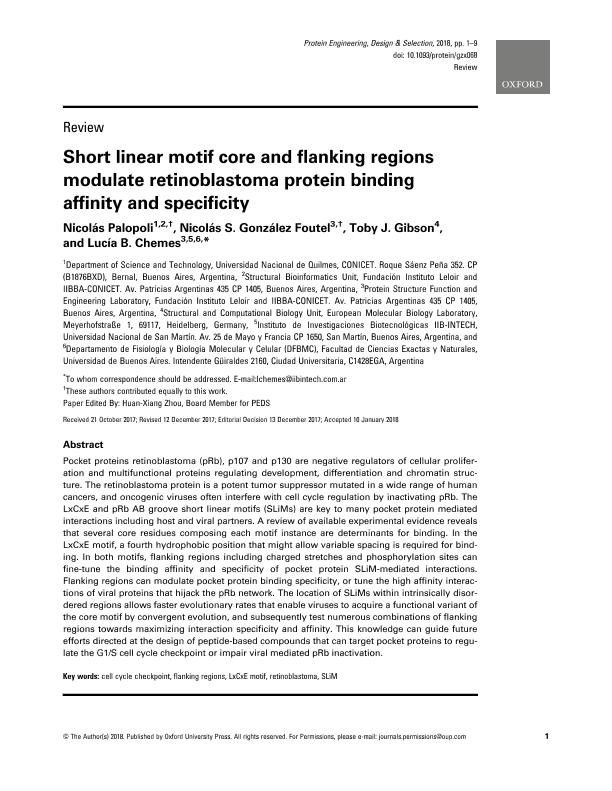Mostrar el registro sencillo del ítem
dc.contributor.author
Palopoli, Nicolás

dc.contributor.author
González Foutel, Nicolás Sebastián

dc.contributor.author
Gibson, Toby J.
dc.contributor.author
Chemes, Lucia Beatriz

dc.date.available
2020-01-21T14:51:26Z
dc.date.issued
2018-03
dc.identifier.citation
Palopoli, Nicolás; González Foutel, Nicolás Sebastián; Gibson, Toby J.; Chemes, Lucia Beatriz; Short linear motif core and flanking regions modulate retinoblastoma protein binding affinity and specificity; Oxford University Press; Protein Engineering Design & Selection; 31; 3; 3-2018; 69-77
dc.identifier.issn
1741-0126
dc.identifier.uri
http://hdl.handle.net/11336/95390
dc.description.abstract
Pocket proteins retinoblastoma (pRb), p107 and p130 are negative regulators of cellular proliferation and multifunctional proteins regulating development, differentiation and chromatin structure. The retinoblastoma protein is a potent tumor suppressor mutated in a wide range of human cancers, and oncogenic viruses often interfere with cell cycle regulation by inactivating pRb. The LxCxE and pRb AB groove short linear motifs (SLiMs) are key to many pocket protein mediated interactions including host and viral partners. A review of available experimental evidence reveals that several core residues composing each motif instance are determinants for binding. In the LxCxE motif, a fourth hydrophobic position that might allow variable spacing is required for binding. In both motifs, flanking regions including charged stretches and phosphorylation sites can fine-tune the binding affinity and specificity of pocket protein SLiM-mediated interactions. Flanking regions can modulate pocket protein binding specificity, or tune the high affinity interactions of viral proteins that hijack the pRb network. The location of SLiMs within intrinsically disordered regions allows faster evolutionary rates that enable viruses to acquire a functional variant of the core motif by convergent evolution, and subsequently test numerous combinations of flanking regions towards maximizing interaction specificity and affinity. This knowledge can guide future efforts directed at the design of peptide-based compounds that can target pocket proteins to regulate the G1/S cell cycle checkpoint or impair viral mediated pRb inactivation.
dc.format
application/pdf
dc.language.iso
eng
dc.publisher
Oxford University Press

dc.rights
info:eu-repo/semantics/openAccess
dc.rights.uri
https://creativecommons.org/licenses/by-nc-sa/2.5/ar/
dc.subject
CELL CYCLE CHECKPOINT
dc.subject
FLANKING REGIONS
dc.subject
LXCXE MOTIF
dc.subject
RETINOBLASTOMA
dc.subject
SLIM
dc.subject.classification
Bioquímica y Biología Molecular

dc.subject.classification
Ciencias Biológicas

dc.subject.classification
CIENCIAS NATURALES Y EXACTAS

dc.subject.classification
Bioquímica y Biología Molecular

dc.subject.classification
Ciencias Biológicas

dc.subject.classification
CIENCIAS NATURALES Y EXACTAS

dc.title
Short linear motif core and flanking regions modulate retinoblastoma protein binding affinity and specificity
dc.type
info:eu-repo/semantics/article
dc.type
info:ar-repo/semantics/artículo
dc.type
info:eu-repo/semantics/publishedVersion
dc.date.updated
2019-11-25T17:43:53Z
dc.journal.volume
31
dc.journal.number
3
dc.journal.pagination
69-77
dc.journal.pais
Reino Unido

dc.journal.ciudad
Oxford
dc.description.fil
Fil: Palopoli, Nicolás. Consejo Nacional de Investigaciones Científicas y Técnicas. Oficina de Coordinación Administrativa Parque Centenario. Instituto de Investigaciones Bioquímicas de Buenos Aires. Fundación Instituto Leloir. Instituto de Investigaciones Bioquímicas de Buenos Aires; Argentina. Universidad Nacional de Quilmes. Departamento de Ciencia y Tecnología; Argentina
dc.description.fil
Fil: González Foutel, Nicolás Sebastián. Consejo Nacional de Investigaciones Científicas y Técnicas. Oficina de Coordinación Administrativa Parque Centenario. Instituto de Investigaciones Bioquímicas de Buenos Aires. Fundación Instituto Leloir. Instituto de Investigaciones Bioquímicas de Buenos Aires; Argentina
dc.description.fil
Fil: Gibson, Toby J.. European Molecular Biology Laboratory; Alemania
dc.description.fil
Fil: Chemes, Lucia Beatriz. Universidad de Buenos Aires. Facultad de Ciencias Exactas y Naturales. Departamento de Fisiología, Biología Molecular y Celular; Argentina. Consejo Nacional de Investigaciones Científicas y Técnicas. Centro Científico Tecnológico Conicet - La Plata. Instituto de Investigaciones Biotecnológicas. Universidad Nacional de San Martín. Instituto de Investigaciones Biotecnológicas; Argentina
dc.journal.title
Protein Engineering Design & Selection

dc.relation.alternativeid
info:eu-repo/semantics/altIdentifier/url/http://academic.oup.com/peds/advance-article/doi/10.1093/protein/gzx068/4821719
dc.relation.alternativeid
info:eu-repo/semantics/altIdentifier/doi/http://dx.doi.org/10.1093/protein/gzx068
Archivos asociados
